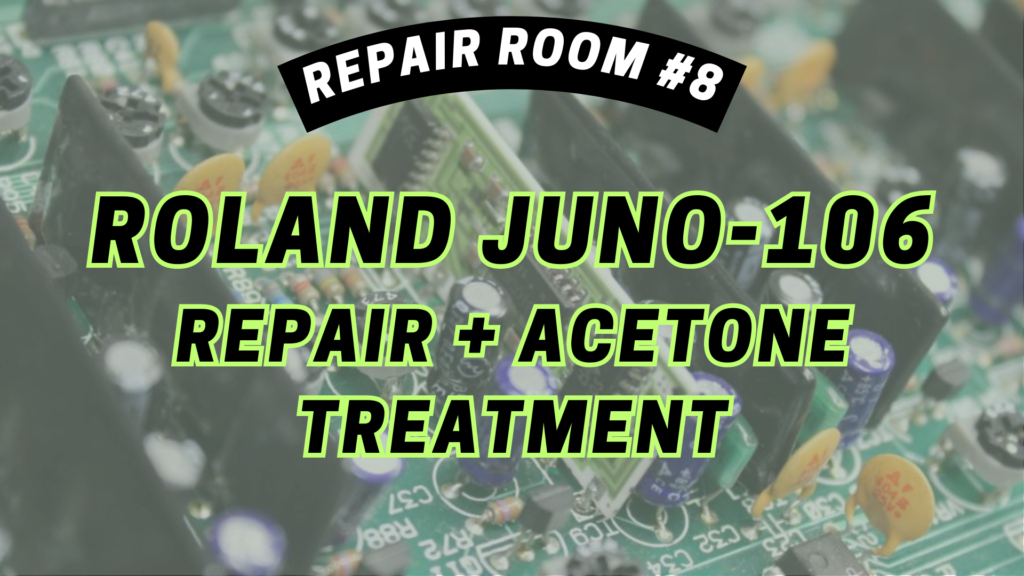
This blog series usually deals with repairing guitar effects equipment. Today, however, we will turn our attention to a popular synthesizer from 1984 – the Roland Juno-106 Analog Polyphonic Synthesizer. This particular post deals with the popular Juno-106 acetone treatment.
As a member of the Reverb Partner Program and as an Amazon Associate, StompboxElectronics earns from, and is supported by, qualifying purchases.
Disclaimer: Stompbox Electronics and/or the author of this article is/are not responsible for any mishaps that occur as a result of applying this content.
The Juno-106 Voice Chip Problem
The Juno-106 is an absolute beast of a synthesizer. Recently, a common problem has been apparent: failure of the Roland AR80017 voice chips. If you’re reading this, you’re probably suspecting the voice chips to be the reason for your faulty Juno.
Troubleshooting the Juno-106 Voice Chips
Luckily, Roland provided the Juno-106 with a troubleshooting method for checking whether the voice chips are working properly. EXPLORING AUDIO explains it best in his YouTube video “ROLAND JUNO 106 : VOICE CHIP ISSUES.” You can also find the procedure on page 18 in the Juno’s service manual, found here.
Removing the Juno-106 Voice Chips
Once the problem is isolated to the Juno’s voice chips, this procedure described by Jeroen Allaert of Analogue Renaissance can be used to remove them. Allaert has done some remarkable work on the AR80017A voice chip; he’s even re-engineered a replica that can be purchased on eBay (paid link).
The Juno-106 Acetone Treament
Once the chips are removed it’s time for the dissolving process! Fill a glass container with 100% acetone and submerge the chips so the acetone completely covers them. Let that sit for 24-48 hours and check the condition of the outer epoxy resin cover. You can tell when the acetone has done its job by how disassociated the resin becomes.
Gently peel off the larger chunks of resin and use a small tool (something similar to a precision flat-head screwdriver) for removing the smaller bits of resin left behind.
Fun fact: The reason acetone is used is because its a solvent for plastics (rubbers, polyethylene, etc.). It does a great job at breaking down polymers, and the epoxy resin encasing the voice chip is a decent candidate for the dissolving reaction. You can also remove glue using this method!
Replacing the Voice Chips
Once most of the resin is removed, solder the voice chips back onto the board. A tool for propping the board on its side is essential to easily solder the chips back into place. One suggestion is to use a pair “helping hands”, available on Amazon. Solder one pin to support the chip on the board, then solder the rest of the pins with relative ease.
Watch the Full Video
I made an entire video detailing the process in January 2021. I describe the troubleshooting process, Juno 106 Voice Chip replacements, and a few technicals about the voice chips themselves that you might or might not find useful. Watch it here on YouTube.

Meet the Author:

Hi, I’m Dominic. By day, I’m an engineer. By night, I repair and modify guitar effects! Since 2017, I’ve been independently modifying and repairing guitar effects and audio equipment under Mimmotronics Effects in Western New York. After coming out with a series of guitar effects development boards, I decided the next step is to support that community through content on what I’ve learned through the years. Writing about electronics gives me great joy, particularly because I love seeing what others do with the knowledge they gain about guitar effects and audio circuits. Feel free to reach out using the contact form!
Spotlight
This fix was done for Cody Morse of the Buffalo, NY based band Deadwolf. See their feature in the Buffalo internet TV show, the Attic.
The Tools I Use
As a member of Amazon Associates, Stompbox Electronics earns and is supported by qualifying purchases.














